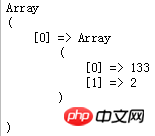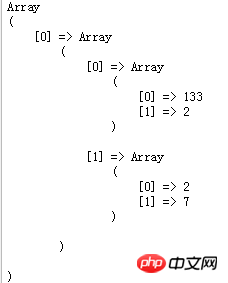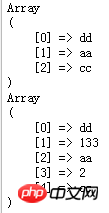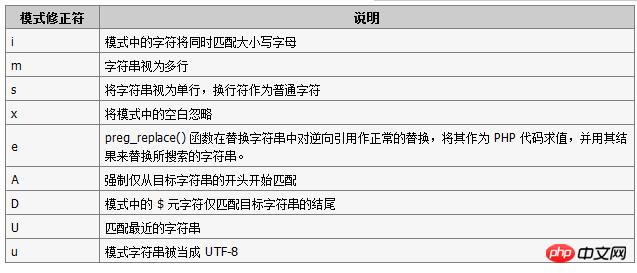Learn more about php regular expressions
This article mainly introduces an in-depth understanding of PHP regular expressions. Interested friends can refer to it. I hope it will be helpful to everyone.
php regular expression sharing:
1. Create a regular expression
$regex = '/\d/i';
It's a bit similar to the first method in JavaScript, except that the word here is a string.
2. Special characters in regular expressions
Special characters are: . \ * ? [ ^ ] $ ( ) { } = ! < > | : -
##3. Functions in regular expressions
There are 8 methods,preg_match and preg_match_all, preg_replace and preg_replace_callback, preg_grep, preg_split, preg_last_error and preg_quote.
preg_match:
Perform a regular expression match
Return the number of matches of pattern. Its value will be 0 times (no match) or 1 time, because preg_match() will stop searching after the first match.
$subject = "dd133aa2"; $pattern = '/\d+/'; preg_match($pattern, $subject, $matches, PREG_OFFSET_CAPTURE); print_r($matches);

preg_match_all:
Performs a "global" regular expression match
preg_match_all($pattern, $subject, $matches, PREG_OFFSET_CAPTURE); print_r($matches);

preg_replace:
Perform a regular expression search and replace
$subject = array("dd133aa2", "kk1ff3");
$pattern = '/\d+/';
$result = preg_replace($pattern, 'Z', $subject);
print_r($result);
##preg_replace_callback: Perform a regular expression search and use a "callback" to replace
 The behavior of this function is to specify a callback instead of replacement to replace characters. The calculation of the string is otherwise equivalent to preg_replace(), including the returned result.
The behavior of this function is to specify a callback instead of replacement to replace characters. The calculation of the string is otherwise equivalent to preg_replace(), including the returned result.
The following code is also replaced with a capital "Z". The content of each $matches in the callback function is the commented part of the code. The first time is 133 and the second time is 2.
$subject = "dd133aa2";
$pattern = '/\d+/';
$result = preg_replace_callback($pattern, function($matches) {
//$matches [0] => 133
//$matches [0] => 2
return 'Z';
}, $subject);
print_r($result);preg_grep: Returns the array entries matching the pattern
 Returns an array
Returns an array
In the sample code below, I added "ddsdfd" to the $subject array, which does not contain numbers. When doing matching, I filtered out the ones without numbers.
What $result2 prints is just the opposite. It prints the filtered one, but the key is still 2, not 0.$subject = array("dd133aa2", "kk1ff3", "ddsdfd");
$pattern = '/\d+/';
$result = preg_grep($pattern, $subject);
$result2 = preg_grep($pattern, $subject, PREG_GREP_INVERT);
print_r($result);
print_r($result2);
##preg_split:
Separate strings by a regular expression 返回一个使用 pattern 边界分隔 subject 后得到 的子串组成的数组。 下面代码中,我将$pattern中的表达式加了括号,为了在$result2中捕获到。 preg_last_error: 返回最后一个PCRE正则执行产生的错误代码 preg_quote: 转义正则表达式字符 返回转义后的字符串。 下面的代码中,$subject中有两个需要转义的字符,“.”和“?”。 将$result打印出后是“dd\.a\?a2cc”,而在$result2中,多加了个参数“a”,这样的话“a”也会被转义,“dd\.\a\?\a2cc”
$subject = "dd133aa2cc";
$pattern = '/(\d+)/';
$result = preg_split($pattern, $subject);
$result2 = preg_split($pattern, $subject, null, PREG_SPLIT_DELIM_CAPTURE);
print_r($result);
print_r($result2);

preg_match('/(?:\D+|<\d+>)*[!?]/', 'foobar foobar foobar');
$result = preg_last_error();//PREG_BACKTRACK_LIMIT_ERROR 调用回溯限制超出
print_r($result);

$subject = "dd.a?a2cc";
$result = preg_quote($subject);
$result2 = preg_quote($subject, 'a');
print_r($result);
print_r($result2);
4、模式修正符

总结:以上就是本篇文的全部内容,希望能对大家的学习有所帮助。
相关推荐:
The above is the detailed content of Learn more about php regular expressions. For more information, please follow other related articles on the PHP Chinese website!

Hot AI Tools

Undresser.AI Undress
AI-powered app for creating realistic nude photos

AI Clothes Remover
Online AI tool for removing clothes from photos.

Undress AI Tool
Undress images for free

Clothoff.io
AI clothes remover

Video Face Swap
Swap faces in any video effortlessly with our completely free AI face swap tool!

Hot Article

Hot Tools

Notepad++7.3.1
Easy-to-use and free code editor

SublimeText3 Chinese version
Chinese version, very easy to use

Zend Studio 13.0.1
Powerful PHP integrated development environment

Dreamweaver CS6
Visual web development tools

SublimeText3 Mac version
God-level code editing software (SublimeText3)

Hot Topics
 PHP regular expression validation: number format detection
Mar 21, 2024 am 09:45 AM
PHP regular expression validation: number format detection
Mar 21, 2024 am 09:45 AM
PHP regular expression verification: Number format detection When writing PHP programs, it is often necessary to verify the data entered by the user. One of the common verifications is to check whether the data conforms to the specified number format. In PHP, you can use regular expressions to achieve this kind of validation. This article will introduce how to use PHP regular expressions to verify number formats and provide specific code examples. First, let’s look at common number format validation requirements: Integers: only contain numbers 0-9, can start with a plus or minus sign, and do not contain decimal points. floating point
 How to validate email address in Golang using regular expression?
May 31, 2024 pm 01:04 PM
How to validate email address in Golang using regular expression?
May 31, 2024 pm 01:04 PM
To validate email addresses in Golang using regular expressions, follow these steps: Use regexp.MustCompile to create a regular expression pattern that matches valid email address formats. Use the MatchString function to check whether a string matches a pattern. This pattern covers most valid email address formats, including: Local usernames can contain letters, numbers, and special characters: !.#$%&'*+/=?^_{|}~-`Domain names must contain at least One letter, followed by letters, numbers, or hyphens. The top-level domain (TLD) cannot be longer than 63 characters.
 How to match timestamps using regular expressions in Go?
Jun 02, 2024 am 09:00 AM
How to match timestamps using regular expressions in Go?
Jun 02, 2024 am 09:00 AM
In Go, you can use regular expressions to match timestamps: compile a regular expression string, such as the one used to match ISO8601 timestamps: ^\d{4}-\d{2}-\d{2}T \d{2}:\d{2}:\d{2}(\.\d+)?(Z|[+-][0-9]{2}:[0-9]{2})$ . Use the regexp.MatchString function to check if a string matches a regular expression.
 Master regular expressions and string processing in Go language
Nov 30, 2023 am 09:54 AM
Master regular expressions and string processing in Go language
Nov 30, 2023 am 09:54 AM
As a modern programming language, Go language provides powerful regular expressions and string processing functions, allowing developers to process string data more efficiently. It is very important for developers to master regular expressions and string processing in Go language. This article will introduce in detail the basic concepts and usage of regular expressions in Go language, and how to use Go language to process strings. 1. Regular expressions Regular expressions are a tool used to describe string patterns. They can easily implement operations such as string matching, search, and replacement.
 PHP regular expressions: exact matching and exclusion of fuzzy inclusions
Feb 28, 2024 pm 01:03 PM
PHP regular expressions: exact matching and exclusion of fuzzy inclusions
Feb 28, 2024 pm 01:03 PM
PHP Regular Expressions: Exact Matching and Exclusion Fuzzy inclusion regular expressions are a powerful text matching tool that can help programmers perform efficient search, replacement and filtering when processing text. In PHP, regular expressions are also widely used in string processing and data matching. This article will focus on how to perform exact matching and exclude fuzzy inclusion operations in PHP, and will illustrate it with specific code examples. Exact match Exact match means matching only strings that meet the exact condition, not any variations or extra words.
 How to verify password using regular expression in Go?
Jun 02, 2024 pm 07:31 PM
How to verify password using regular expression in Go?
Jun 02, 2024 pm 07:31 PM
The method of using regular expressions to verify passwords in Go is as follows: Define a regular expression pattern that meets the minimum password requirements: at least 8 characters, including lowercase letters, uppercase letters, numbers, and special characters. Compile regular expression patterns using the MustCompile function from the regexp package. Use the MatchString method to test whether the input string matches a regular expression pattern.
 Chinese character filtering: PHP regular expression practice
Mar 24, 2024 pm 04:48 PM
Chinese character filtering: PHP regular expression practice
Mar 24, 2024 pm 04:48 PM
PHP is a widely used programming language, especially popular in the field of web development. In the process of web development, we often encounter the need to filter and verify text input by users, among which character filtering is a very important operation. This article will introduce how to use regular expressions in PHP to implement Chinese character filtering, and give specific code examples. First of all, we need to clarify that the Unicode range of Chinese characters is from u4e00 to u9fa5, that is, all Chinese characters are in this range.
 What are the regular expression wildcards?
Nov 17, 2023 pm 01:40 PM
What are the regular expression wildcards?
Nov 17, 2023 pm 01:40 PM
Regular expression wildcards include ".", "*", "+", "?", "^", "$", "[]", "[^]", "[a-z]", "[A-Z] ","[0-9]","\d","\D","\w","\W","\s&quo






